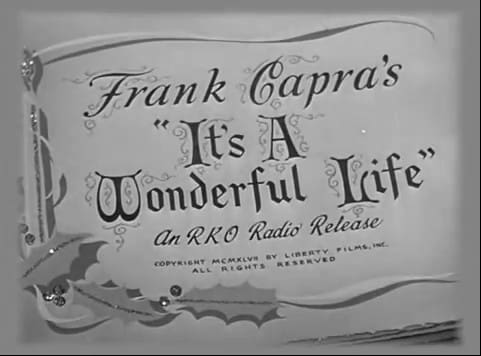Finding Truth in “It’s a Wonderful Life” (Part II of II)
In part one, we looked at the different themes that run through the film “It’s a Wonderful Life.” Today, we will examine why it seems that Pope Francis should like this film and the fact that it succeeded even when many did not consider it a success until much, much later.
I don’t know if Pope Francis likes It’s A Wonderful Life but, in light of recent comments by the Holy Father, it seems he should. Capra attacks the greed of the oppressive Henry F. Potter, while also correcting George’s own  misguided notions. Financial success seems to be the marker for George’s perception of self-worth. He fails repeatedly to succeed in that realm and agonizes over it. (Notice how he responds to every crisis in the film: he references his financial failings.) Potter feeds George’s insecurity, leading George to underestimate the love of his own family and friends while planting the idea that he is “worth more dead than alive” thanks to an insurance policy. Believing the lie leads George to self-destruction – as lies often do.
misguided notions. Financial success seems to be the marker for George’s perception of self-worth. He fails repeatedly to succeed in that realm and agonizes over it. (Notice how he responds to every crisis in the film: he references his financial failings.) Potter feeds George’s insecurity, leading George to underestimate the love of his own family and friends while planting the idea that he is “worth more dead than alive” thanks to an insurance policy. Believing the lie leads George to self-destruction – as lies often do.
There’s a notable absence of the Church in the film. One senses its presence in the film’s characters, but no one ventures through its doors. The main characters are inherently Protestant, while the ethnic representations are clearly Catholic. No doubt Capra did this purposefully, to make the film as accessible to the broadest audience possible while reflecting small-town America as it was then. (It’s a matter of trivia that the movie marquee seen at the climax of the film is The Bells of St. Mary’s, which Capra put in as a nod to his good friend, the director Leo McCarey.)
Though it’s considered a Christmas film, It’s A Wonderful Life was never intended as one. Capra wanted to avoid making it a holiday-only experience, to the extent that it was intended for release late in January 1947, missing the Christmas season completely. But the film’s distributor, RKO, ran into problems with another movie they’d hoped would be their big Christmas hit (Sinbad The Sailor with Douglas Fairbanks Jr), and asked Capra to release It’s A Wonderful Life for Christmas 1946. Presumably, the title cards – with images of Santa – were created to accommodate the change. Otherwise, you won’t find any direct references to the Nativity, though you’ll see traditional Christmas decorations and hear Christmas-related hymns and carols throughout the last quarter of the film. (The original score by Dimitri Tiomkin includes an extended piece not used in the film that included a medley of hymns, carols and the “Joyful” section of Beethoven’s Ninth Symphony.)
Ironically, the film itself was akin to George Bailey. When released, It’s A Wonderful Life did not live up to financial expectations. It performed modestly at the box office and failed to win any of the Academy Awards for which it was nominated. Within a year, it seemed to have faded from memory for Hollywood and the urban critics who readily dismissed its sentimentality. Capra moved on to other projects, assuming he had failed.
But, like George Bailey, the film was a success but didn’t know it until much later. Many people who had seen It’s A Wonderful Life couldn’t shake it off. Capra later remarked that he began responding to letters about the movie from fans in 1947 and the next thing he knew it was 1957 and the letters were still pouring in. Television had kept the film alive in a way he couldn’t have expected, stirring people’s hearts and minds at the deepest levels. Over the next half-century, it would gain an entirely new audience and rapidly rise to the top of lists of the best movies ever made.
I discovered the film while in high school in the mid-70s, having caught it on one of our UHF channels late at night. It impacted me in ways I can hardly explain. And, as a matter of personal trivia, I had the honor of talking to Frank Capra on the phone for two hours specifically about It’s A Wonderful Life. I happened to catch him in his office a couple of years before the rest of the world caught on to the wonder of the movie and put him back in the spotlight until his death in 1991.
There is a lot to be learned from It’s A Wonderful Life. And it’s encouraging to see that its most pervasive themes of sacrifice, community, family and truth come from our own catechism.
Art: Title card of the American film It’s a Wonderful Life (1946), starring Jimmy Stewart and Donna Reed. The film lapsed into the public domain in the United States due to the failure of National Telefilm Associates, the last copyright owner, to renew; 20 December 1946; PD-US; Wikimedia Commons.





